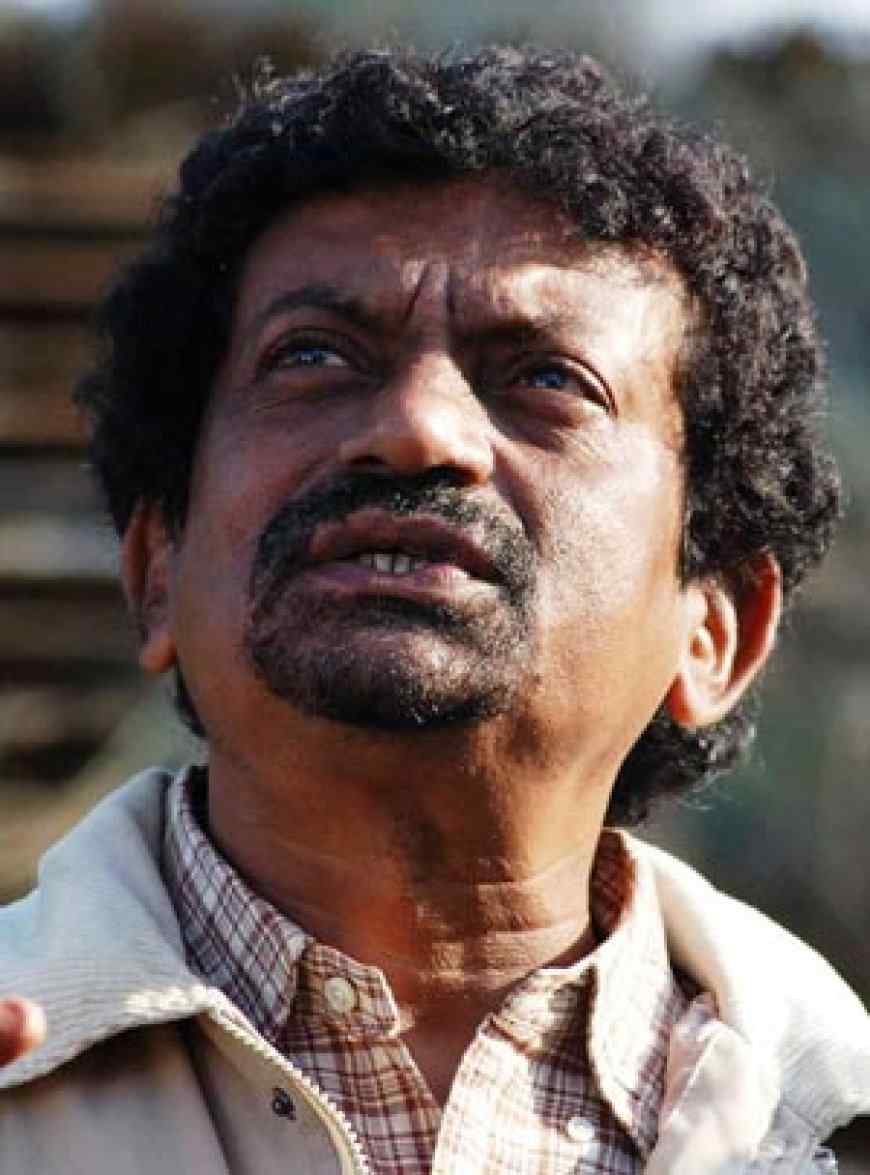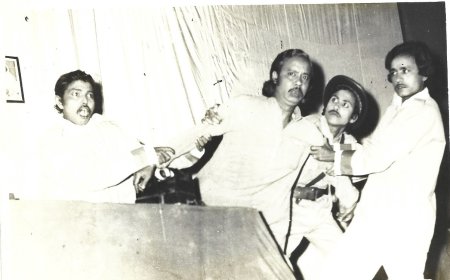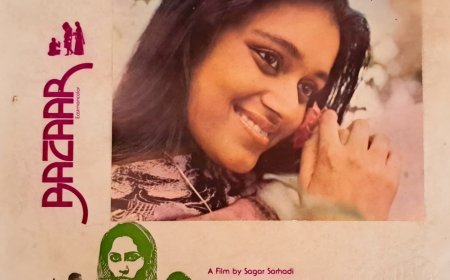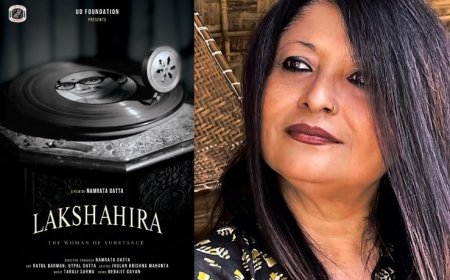LOOKING BACK ON GAUTAM GHOSE'S GUDIA (1997) THE MOST UNDER-RATED FILM BY GHOSE
Dr. Shoma A. Chatterji provides commentary on the Gautam Ghose film "Gudia," an adaptation of a story by Mahasweta Devi.

Gudia, directed by Gautam Ghose and produced by Plus Channel, had its national premiere at the 3rd Calcutta Film Festival. In 1998. Inspired by a short story by Mahasweta Devi, titled Johnny O Urboshi, Ghose took the core theme of a ventriloquist's freedom of expression, and then fleshed it out to define a full-length feature film. a formidable task even for a director of the calibre of Ghose. Especially when one is dealing with a Mahasweta Devi story. But Ghose has always been strongly inspired by literary sources.
According to Gautam, "Bengali literature, I have discovered, has a lot of cinematic elements which does not go against the grain of cinema. Such as my earlier film, Padma Nadir Majhi. Yet, since literature and cinema are two very different media, literature cannot be translated, should not be translated rather, to cinema. But it need not always be literature that inspires me. It could be a news clipping or an incident, certain moments, that appeal to my emotions at a given point of time. But there are certain elements in literature that cannot be brought into cinema and vice versa. For Antarjali Jatra, I was inspired by the simple reason that it did not lend itself to a cinematic interpretation. Its images were purely literary, there were no optical images at all. What fascinated me was the backdrop of the story, and the elemental fury that simmered under the surface, waiting to break out."
Written in 1976, the original story was set against the backdrop of the Naxalite movement in Bengal, stressing on the censorship of an individual's freedom of expression during the Emergency. Ghose has taken this basic theme, through the voice of Johnny, a simple, honest and straightforward ventriloquist. He learns the tricks of this gradually fading art from his guru, Hamid. Hamid entertains his audience through thumris and Punjabi tappas with a strong classical base, as sung in the 'voice' of the beautiful Urvashi, a life-size, female doll who "was never born, will never die and is forever young." When Hamid has throat cancer, he sells Urvashi off to Johnny, with a word of advice: "When you lose your voice, sell her off like I have done. Because without your voice, she cannot entertain. You will age and die, but she will not." Johnny makes certain changes in his ouvre switching from thumris and tappas to Hindi film songs, Goan Catholic songs, regatta music, Latin American music, a bit of jazz. Hamid leaves behind another legacy for Johnny - his obsession for Urvashi. With Johnny's fame spreading far and wide as the small team migrate from Goa to Bombay, political parties pressurise Johnny to use his performing art for their political campaign. Johnny gives in with reluctance. But at the performance level, Urvashi 'refuses to co-operate.' 'She' refuses to 'voice' the lies Johhny tells her to, in effect, unwittingly evolving into Johnny's conscience, his alter-ego and at the same time, his lady-love. Angered at this 'betrayal', a beaten and bruised Johnny casts the dismembered Urvashi into the sea. The slow but steadily growing relationship between Johnny and Urvashi stands out as a metaphor for an artist and his art, be it a film director, a painter, a musician, or a poet. Urvashi remains an integral part of Johnny's life, even when 'she' has visibly disappeared from it. The young girl Rosemary, readily becomes a poor substitute.j
Cinematically, the narrative is structured like the waves of the sea, which form the main backdrop of the film. Gudia thus, is a metaphor for life, for humanity, for the inseparable, almost unified relationship between the artist and his art. Johnny's life rises and falls like the waves of the sea he is so fond of, more so when he loses Gudia to those waves, coming back the next morning to find out if the fishermen's morning catch has brought her back. While Johnny is linked to the restless movement of the sea, waves on the shore and the sky in the backdrop, Rosemary is perhaps linked to the moon, and the still surfaces of the water, sometimes broken by ripples. Yet, Rosemary is never able to crack the emotional cocoon within which Johnny has entrapped himself with his Urvashi, even when 'she' is lost to the sea. The single scene of violence does not intrude into the poetic rhythm of the narrative. Music forms an integral leitmotif for the film, outlining the characteristic changes in Johnny's performance and underlining the changing tastes of the audience. Scored by Ghose himself along with Arthur Gracias, to lyrics penned, once again, by Ghose along with Nida Fazli, the songs define the natural, spontaenous rhythm of the film. Seamless editing by Moloy Banerjee expresses the dichotomy in the narrative, the sudden change in the mood and the spirit, when Urvashi 'refuses to mouth lies.'
"The multiple responsibilities of direction, cinematography, music and lyrics are no problem for me because I do them automatically, almost by reflex because I have been used to this from the beginning. As a director myself, I personally feel that the film is a metaphor on a filmmaker and his film. The struggle for survival, the spirit of endurance, the struggle to constantly innovate and improvise, the passion to reach your audience, this is as much a part of the filmmaker as it is a part of Johnny. We are as much in love with our cinema as Johnny loved Urvashi. But his love spoiled his chances of loving a human being because Urvashi was a life-size female doll. a concrete, almost humanised being he could identify with and love as a woman at the same time" says Ghose.
"We live in half-truths, at home, in society, among the public" he goes on. "Because Truth is absolute. We refrain from using this absolute because we are conditioned by life and experience that using the absolute Truth can disturb the equanimity of our lives. With Urvashi's 'help', Johnny tried to reach the Absolute, because 'she' refused to 'mouth half-truths' even at his bidding. The political pressure on Johnny is where I deviated from the original story. You will notice I have used a lot of mirrors in the interiors, both with Hamid and with Johnny, also with Rosemary. That is the challenge of a cinematographer, and is also a reflection of the performing artist. I wished to pay my humble tribute to this group of talented performers and musicians, a neglected, marginalised lot. Music is not an entertaining part of the film. It is an important character which plays out its own role. I never intended to make a musical" says Gautam.
"All art is distanced" writes Dana Poal in his incisive essay on Brechtian cinema. But with Gudia, Ghose bridges this gap between the artist and his art, and somewhere along the narrative, the audience in the theatre meshes with the audience of Johnny's beautiful performance within the film. A pity that a film like this was shunted out of the Indian Panorama that year.
***
What's Your Reaction?



































































